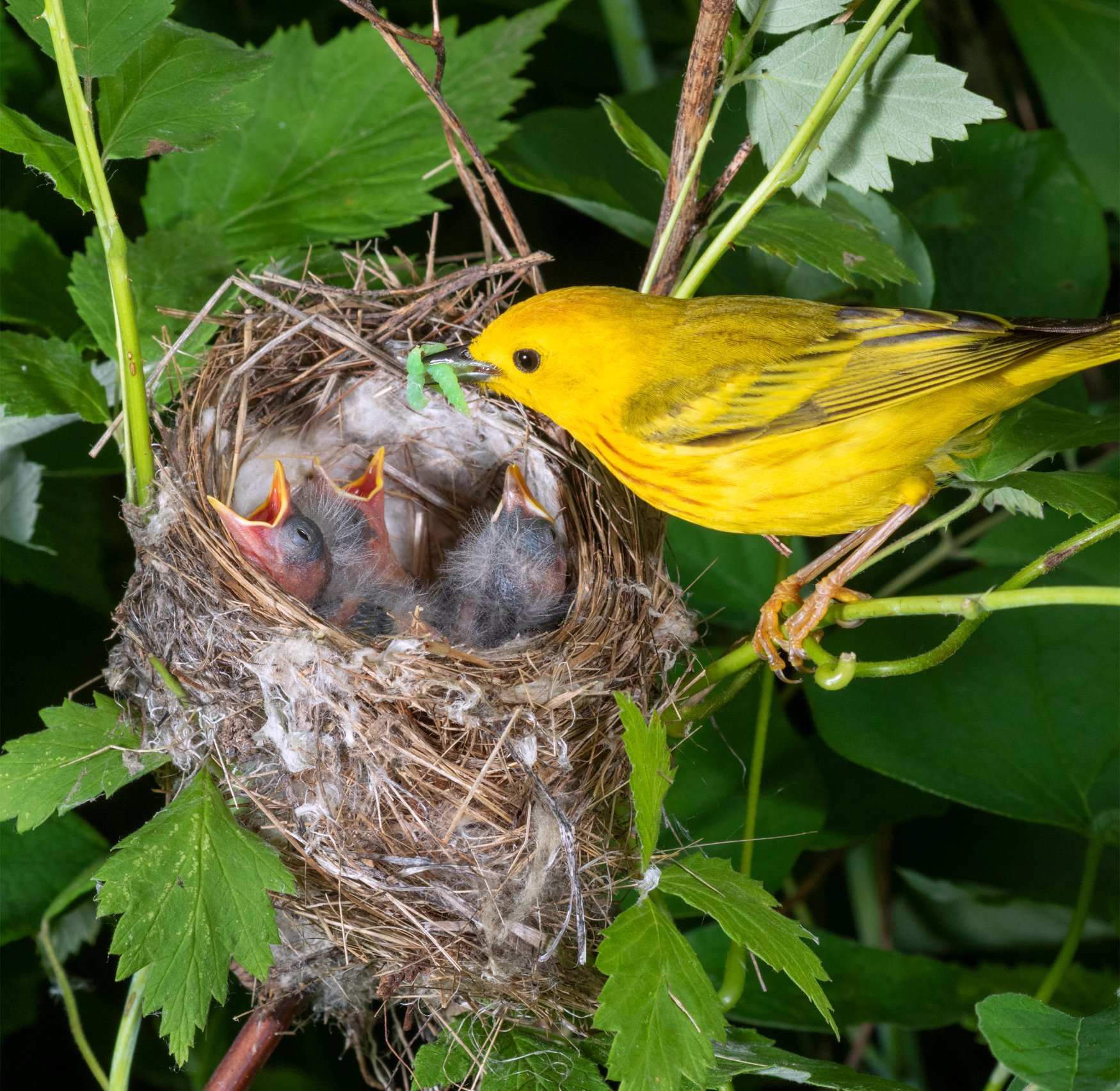Black Raspberries, like Fox Grapes and Muscadine Grapes, are one of the few native fruit crops that have been used in modern agricultural systems. There are even a few cultivars that are pure Black Raspberry, non-hybridized, such as ‘Jewel’, ‘MacBlack’, and ‘Munger’. Black Raspberries don’t require a full day’s sun exposure to yield well, adaptable to as low as 6 hours of direct sunlight for respectable yields. If you’re planning on growing them for wildlife food, they will attract mostly native birds in the early summer during their fruiting period.
A Yellow Warbler (Setophaga petechia) feeds its nestlings within a Black Raspberry Thicket
Savanna Planting Pattern for Native Plant Agriculture
The best biologically productivity with a Black Raspberry acreage is to infuse competition friendly savanna trees at 10 to 15 trees per acre. These could be Shagbark Hickory, Red Hickory, Persimmon, Black Cherry, Black Walnut, or Honeylocust. Persimmon, Black Cherry, and Honeylocust carrying higher stocking rates per acre (15), and Black Walnut and Hickory carrying lower stocking rates per acre (10) for proper sun exposure. The combination of the spaced out native trees and thick undergrowth of Black Raspberry would result in a high diversity of native insects and their predators co-existing in the planting.
Planting in the Residential Landscape
Black Raspberries perform best on Eastern, Western, or Northern faced slopes or flatter ground in the home landscape. If you choose to put them up against your house, they will tolerate every orientation except the Northside of your home as there isn’t enough sun for them on the Northside. They tolerate full sun within average moisture soils or higher moisture soils. They are also very tolerant of partial shade. The key to vigorous Black Raspberry growth and fruit production is providing them with 2 inches of water during exceptional summer droughts. Because they fruit in early summer before mid summer droughts take place; watering during the mid summer makes the more vigorous the following year as they’re able to store up more energy through drought-free photosynthesis. The thorns on Black Raspberry aren’t as formidable as wild black berries, so berry picking can be a bit more peaceful with this species. Still the thorns provide enough defense for the Black Raspberry thickets to be chosen by nesting native birds such as the Yellow Warbler Pictured above.
CLick Images Below to Expand Them
Select/click the images above to expand them then click/tap to advance to the next picture. Also, Turn your cellphone side ways for horizontal pictures, and straight up and down for vertical pictures.
The Rubus genus is widely used as insect host plants and their flowers are an essential nectar/pollen source in the spring landscape of moist prairies, fields, wetland margins, savannas, and open woodlands. They bloom at the same time as many forest spring ephemerals that are in decline from White Tail Deer overpopulation, deforestation, and invasive shrub encroachment. So Black Raspberries help buffer the resources of early foraging pollinators with their highly accessible flowers during the mid spring. Blackberries and Raspberry species are known to support over 150 native moth/butterfly caterpillars. So not only do they provide this essential mid spring pollen/nectar - they also produce caterpillars throughout the summer that are forged for by native birds.
Germination Tips: Black Raspberries require acid scarification to germinate. This mimics the process the seeds would undergo if they were eaten by an animal. After thoroughly crushing the fruit up, exposing the seeds, expose the fruit/seed mash to Sulfuric Acid for 25 minutes. Use retail strength Sulfuric Acid with goggles and chemical gloves and rinse this acid from the seed/fruit mash after the 25 minutes of submersion. Then place the seeds in silty soil within a pot, buried halfway underground. This would happen in Early summer for Black Raspberry as that’s when the fruit ripen. Let the pot sit outdoors all summer, fall, and winter. Then in spring time rinse the silty soil away with a strainer thin enough to catch the seeds, separating them from the silty soil. Sow the seeds in early spring/late winter and expect germination by late spring. This process can also be used for Blackberry species which mature later in the summer.
Receive 40% off of our Native Plant Propagation Guide/Nursery Model book when purchased as a package. deal with either our Native Meadowscaping book or our Native Plant Agriculture book at this link.
Learn about what our Native Meadowscaping book has to offer here at this link.
Learn about what our Native Plant Agriculture Vol. 1 book has to offer here at this link.
Learn about what our Native Plant Propagation Guide & Nursery Model has to offer here at this link.











